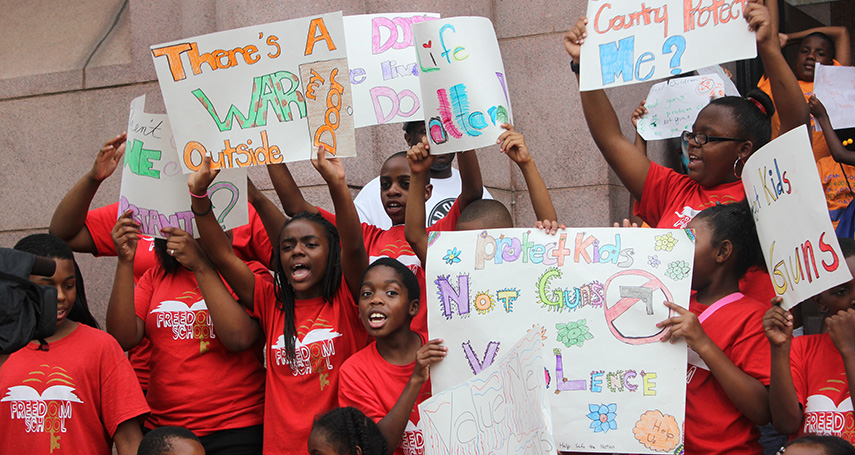As our nation slowly regains a sense of normalcy on the other side of the pandemic, another epidemic remains prevalent and continues to decimate communities, especially communities of color. Gun violence remains the number one cause of death for children ages 1-1991, with the gun death rate for children at almost 5 in every 100,000 in 2020.92
Babies born the year of the watershed Columbine massacre are now 24 years old. No youth today knows a world without the threat of sudden deadly gun violence. The pandemic only exacerbated their skepticism that something like a safe space exists anywhere in their communities. In 2017, the CDC reported that 3,410 children and teens were killed and 18,201 were injured with guns. In 2021, fatalities increased nearly 40% to 4,739, accounting for 13 child deaths daily related to gun violence, the highest annual number ever recorded (see Table 36).
Even as these numbers increase and continue to gain recognition across a national stage, Congress and many states remain stagnant on enacting adequate gun violence prevention measures, resulting in the loss of young lives and holes in families and in communities that will never be repaired. With the COVID-19 pandemic behind us, we cannot afford to now normalize the more persistent public health crisis of gun violence.
Communities of color and children of color in particular suffer gun violence at rates disproportionate to that of their White counterparts:
- In 2021, Black children and teens were six times as likely to die from gun violence as their White peers.93 Of the Black children that died from gun violence, a vast majority are boys, who are dying at much greater rates than White children.
- Black children and teens had the highest gun death rate in 2021 (20.5 deaths per 100,000 children).94 This is up from 2019 where Black children and teens also had the highest gun death rate (11.9 per 100,000).95
- American Indian/Alaskan Native children and teens followed at (7.2 deaths per 100,000).96 This is also up from 2019 where American Indian/Alaskan Native children had a gun death rate of (6.4 per 100,000). 97
- Gun-related deaths rates were the lowest for White children (3.3 per 100,000).98
Gun-related deaths among children and teens are growing, and no state is exempt from the impact and effects of this growing epidemic. The past 10 years of available trend data (2011-2020) illustrate disparities across and between the states, illuminating the places where swift and immediate action is urgent, needed, and dire.
- Half of all child and teen gun deaths occurred in just 10 states: Texas, California, Illinois, Georgia, Florida, Ohio, North Carolina, Louisiana, Pennsylvania, and Missouri (see Table 36).
- Gun-related death rates are highest in Alaska. Alaskan children and teens have been killed with guns at a rate of 9 deaths per 100,000 children (see Table 36).
- Gun-related deaths occur at more than twice the national average in Louisiana, where more than 8 children per 100,000 have been shot and killed over the past decade (see Table 36).
- Massachusetts has the lowest gun-related death rates, with 1 gun-related child death per 100,000 (see Table 36).
- Other states with relatively low rates—rates that are less than half the national average—are New York, Connecticut, New Jersey, and New Hampshire (see Table 36).
Children deserve the opportunity to be children. Our nation’s young people deserve the chance to have a childhood free from violence and a country with leaders who ensure that they are safe in their schools, neighborhoods, and communities. Elected national, state, and local officials have enabled this violent epidemic to grow and ravage communities, specifically communities of color. It is well past time for action that ensures our children can thrive and not just try to survive.
[92] “What the data says about gun deaths in the U.S.,” Pew Research Center, February 3, 2022. Retrieved from:https://www.pewresearch.org/fact-tank/2022/02/03/what-the-data-says-about-gun-deaths-in-the-u-s/
[93] “Childhood’s Greatest Danger: The data on kids and gun violence,” The New York Times Magazine, December 14, 2022. Retrieved from: https://www.nytimes.com/interactive/2022/12/14/magazine/gun-violence-children-data-statistics.html
[94] 56 (table)
[95] Centers for Disease Control and Prevention, National Center for Health Statistics. Detailed Mortality Files, Underlying Cause of Death 2018-2021, Accessed using CDC WONDER Online Database. http://wonder.cdc.gov/ucd-icd10.html.
[96] The State of America’s Children 2021 Report, Children’s Defense Fund
[97] Centers for Disease Control and Prevention, National Center for Health Statistics. Detailed Mortality Files, Underlying Cause of Death 2018-2021, Accessed using CDC WONDER Online Database. http://wonder.cdc.gov/ucd-icd10.html.
[98] The State of America’s Children 2021 Report, Children’s Defense Fund
[99] Centers for Disease Control and Prevention, National Center for Health Statistics. Detailed Mortality Files, Underlying Cause of Death 2018-2021, Accessed

